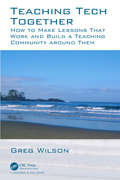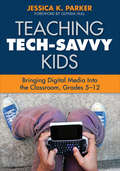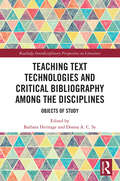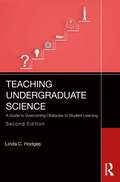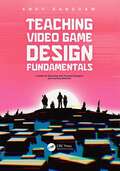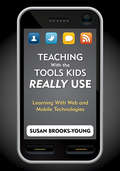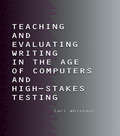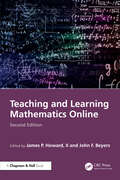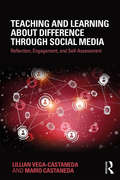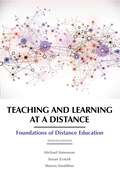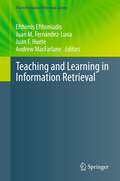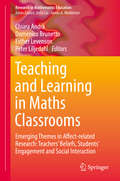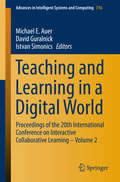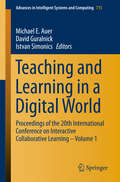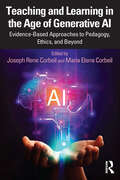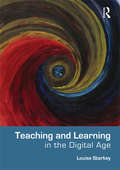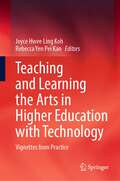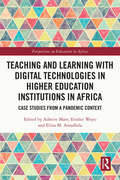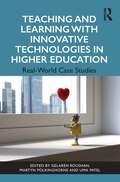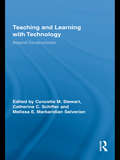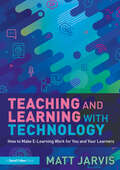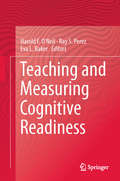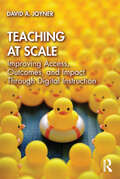- Table View
- List View
Teaching Tech Together: How to Make Your Lessons Work and Build a Teaching Community around Them
by Greg WilsonHundreds of grassroots groups have sprung up around the world to teach programming, web design, robotics, and other skills outside traditional classrooms. These groups exist so that people don't have to learn these things on their own, but ironically, their founders and instructors are often teaching themselves how to teach. There's a better way. This book presents evidence-based practices that will help you create and deliver lessons that work and build a teaching community around them. Topics include the differences between different kinds of learners, diagnosing and correcting misunderstandings, teaching as a performance art, what motivates and demotivates adult learners, how to be a good ally, fostering a healthy community, getting the word out, and building alliances with like-minded groups. The book includes over a hundred exercises that can be done individually or in groups, over 350 references, and a glossary to help you navigate educational jargon.
Teaching Tech-Savvy Kids: Bringing Digital Media Into the Classroom, Grades 5-12
by Jessica K. ParkerStudents are plugged in, powered up, and connected. Are you? The author gives teachers a deeper understanding of the dynamic potential for increasing student learning through digital media. Based on a three-year study of youth and their use of new media, this teacher-friendly resource includes: Descriptions of digital tools such as social networking platforms, YouTube, Wikipedia, virtual worlds, digital music, and more Vignettes about how young people use digital media Sidebars debunking common myths about technology Advice about navigating digital media for both novice and expert teachers Pedagogical implications and practices, including sample activities
Teaching Text Technologies and Critical Bibliography Among the Disciplines: Objects of Study (Routledge Interdisciplinary Perspectives on Literature)
by Barbara Heritage Donna A. C. SyTeaching Text Technologies and Critical Bibliography Among the Disciplines: Objects of Study is a richly illustrated volume consisting of 23 methods-based chapters discussing innovative and often experimental approaches to hands-on teaching with material texts. Featuring 47 contributors whose work ranges from digital humanities, librarianship, curation, and conservation to architecture, culinary history, fine art, literary history, and the history of science, the collection builds on new work in the areas of text technologies and critical bibliography—emerging scholarly approaches being embraced in the humanities. The book features established experts in bibliography, the history of the book, manuscript studies, and textual editing, as well as educators and students who are applying new critical bibliographical methods (e.g., Black bibliography) to their pedagogy. The result is a dynamic cross-disciplinary, cross-generational exchange modeling inclusive pedagogies with textual artifacts and illuminating how object-oriented teaching can harness the insights of diverse branches of practice and learning.
Teaching Undergraduate Science: A Guide to Overcoming Obstacles to Student Learning
by Linda C. HodgesTeaching Undergraduate Science: A Guide to Overcoming Obstacles to Student Learning offers college and university instructors evidence-based strategies to help students learn those specific skills and habits of mind necessary for succeeding in STEM fields.Updated and expanded from the first edition, this text elaborates on critical factors in cultivating student success, including how to engender a sense of belonging and agency in STEM, engage students in their learning, and foster deliberate practice. Hodges provides frank guidance on the relative effort and outcomes for each strategy, allowing instructors to choose techniques best suited to their aims and contexts. While focusing primarily on face-to-face classes, this resource also addresses how to work between online resources and physical spaces. Hodges’ years of experience working as and with STEM faculty provides a personal connection to the research shared, producing an accessible, practical, and enjoyable read.
Teaching Video Game Design Fundamentals: A Guide for Educating with Practical Examples and Learning Materials
by Andy SandhamThis comprehensive guide provides educators with everything they need to teach video game design fundamentals. With ready-made lesson plans, practical examples, assignment templates, exercises, video walkthroughs and learning materials in a modular format that allows for customization, it makes it easy to tailor lesson plans to meet the unique needs of your students, turning your classroom into an immersive learning environment that inspires creativity and innovation.The book offers a variety of exercises and learning materials to engage all types of learners, additionally with materials designed for different learning speeds that help them progress at a pace that suits them. With this book, you can ensure that all students have the opportunity to succeed and reach their full potential.This book will be vital reading to both educators teaching, and students learning, game design.
Teaching With the Tools Kids Really Use: Learning With Web and Mobile Technologies
by Susan J. Brooks-YoungA foundational guide for integrating mobile technologies into your classroom! Designed to help educators deliver relevant instruction through the use of 21st-century technologies, this resource examines available low-cost hardware, explores free Web 2.0 tools, and sheds light on the pros and cons of using mobile technologies for instructional support. Emphasizing the ethical use of technology, the book identifies: Specific Web 2.0 options for supporting collaboration and communication in K–12 settings; Strategies for practical applications; A decision-making model for selecting appropriate mobile technologies and Web 2.0 tools for classroom use; Recommended books, Web sites, and online reports and articles for reference.
Teaching and Digital Technologies
by Michael Henderson Geoff RomeoTeaching and Digital Technologies: Big Issues and Critical Questions helps both pre-service and in-service teachers to critically question and evaluate the reasons for using digital technology in the classroom. Unlike other resources that show how to use specific technologies – and quickly become outdated, this text empowers the reader to understand why they should (or should not) use digital technologies, when it is appropriate (or not), and the implications arising from these decisions. The text directly engages with policy, the Australian Curriculum, pedagogy, learning and wider issues of equity, access, generational stereotypes and professional learning. The contributors to the book are notable figures from across a broad range of Australian universities, giving the text a unique relevance to Australian education while retaining its universal appeal. Teaching and Digital Technologies is an essential contemporary resource for early childhood, primary and secondary pre-service and in-service teachers in both local and international education environments.
Teaching and Evaluating Writing in the Age of Computers and High-Stakes Testing
by Carl WhithausThis book takes on a daunting task: How do writing teachers continue to work toward preparing students for academic and real-world communication situations, while faced with the increasing use of standardized high-stakes testing? Teachers need both the technical ability to deal with this reality and the ideological means to critique the information technologies and assessment methods that are transforming the writing classroom.Teaching and Evaluating Writing in the Age of Computers and High-Stakes Testing serves this dual need by offering a theoretical framework, actual case studies, and practical methods for evaluating student writing. By examining issues in writing assessment--ranging from the development of electronic portfolios to the impact of state-wide, standards-based assessment methods on secondary and post-secondary courses--this book discovers four situated techniques of authentic assessment that are already in use at a number of locales throughout the United States. These techniques stress:*interacting with students as communicators using synchronous and asynchronous environments;*describing the processes and products of student learning rather than enumerating deficits;*situating pedagogy and evaluation within systems that incorporate rather than exclude local variables; and*distributing assessment among diverse audiences.By advocating for a flexible system of communication-based assessment in computer-mediated writing instruction, this book validates teachers' and students' experiences with writing and also acknowledges the real-world weight of the new writing components on the SAT and ACT, as well as on state-mandated standardized writing and proficiency exams.
Teaching and Learning Mathematics Online
by James P. Howard, II and John F. BeyersTeaching and Learning Mathematics Online, Second Edition continues to present meaningful and practical solutions for teaching mathematics and statistics online. It focuses on the problems observed by mathematics instructors currently working in the field who strive to hone their craft and share best practices with the community. The book provides a set of standard practices, improving the quality of online teaching and the learning of mathematics. Instructors will benefit from learning new techniques and approaches to delivering content.New to the Second Edition Nine brand new chapters Reflections on the lessons of COVID-19 Explorations of new technological opportunities
Teaching and Learning about Difference through Social Media: Reflection, Engagement, and Self-assessment
by Lillian Vega-Castaneda Mario CastanedaTeaching and Learning about Difference through Social Media considers the role social media has played in prompting public conversations about difference and diversity, including issues relating to ethnicity, race, religion, political affiliation, gender, and sexual orientation. These issues are addressed in the context of the present political climate. They are also examined with respect to occurrences of hate and violence, including hate crimes and mass fatality events. Using a historical and socio-cultural approach to how we look at these significant issues in the USA, the authors examine the ways difference and diversity are represented in online interactions via social media. In order to encourage a more informed dialogue and critical conversation with students, each chapter includes: discussion questions, self-reflection and self-assessment activities, and suggestions for further reading,. Ideal for courses in diversity and social justice education and beyond, this content and practice-based text integrates the identification of issues of difference and diversity with suggestions for how we can address these issues in the social media age.
Teaching and Learning at a Distance: Foundations of Distance Education
by Susan Zvacek Sharon E. Smaldino Michael R. SimonsonTeaching and Learning at a Distance is written for introductory distance education courses for preservice or in- service teachers, and for training programs that discuss teaching distant learners or managing distance education systems. This text provides readers with the basic information needed to be knowledgeable distance educators and leaders of distance education programs. The teacher or trainer who uses this book will be able to distinguish between appropriate uses of distance education. <p><p>In this text we take the following themes: The first theme is the definition of distance education. Before we started writing the first edition of Teaching and Learning at a Distance we carefully reviewed the literature to determine the definition that would be at the foundation of our writing. This definition is based on the work of Desmond Keegan, but is unique to this book. This definition of distance education has been adopted by the Association for Educational Communications and Technology and by the Encyclopedia Britannica. <p><p>The second theme of the book was the importance of research to the development of the contents of the book. The best practices presented in Teaching and Learning at a Distance are validated by scientific evidence. Certainly there are “rules of thumb”, but we have always attempted to only include recommendations that can be supported by research. <p><p>The third theme of Teaching and Learning at a Distance is derived from Richard Clark’s famous quote published in the Review of Educational Research that states that media are mere vehicles that do not directly influence achievement. Clark’s controversial work is discussed in the book, but is also fundamental to the book’s advocacy for distance education – in other words, we authors did not make the claim that education delivered at a distance was inherently better than other ways people learn. Distance delivered instruction is not a “magical” approach that makes learners achieve more. <p><p>The fourth theme of the book is equivalency theory. Here we presented the concept that instruction should be provided to learners that is equivalent rather than identical to what might be delivered in a traditional environment. Equivalency theory helps the instructional designer approach the development of instruction for each learner without attempting to duplicate what happens in a face to face classroom. <p><p>The final theme for Teaching and Learning at a Distance is the idea that the book should be comprehensive – that it should cover as much of the various ways instruction is made available to distant learners as is possible. It should be a single source of information about the field.
Teaching and Learning in Information Retrieval
by Andrew Macfarlane Juan F. Huete Juan M. Fernández-Luna Efthimis EfthimiadisInformation Retrieval has become a very active research field in the 21st century. Many from academia and industry present their innovations in the field in a wide variety of conferences and journals. Companies transfer this new knowledge directly to the general public via services such as web search engines in order to improve their information seeking experience. In parallel, teaching IR is turning into an important aspect of IR generally, not only because it is necessary to impart effective search techniques to make the most of the IR tools available, but also because we must provide a good foundation for those students who will become the driving force of future IR technologies. There are very few resources for teaching and learning in IR, the major problem which this book is designed to solve. The objective is to provide ideas and practical experience of teaching and learning IR, for those whose job requires them to teach in one form or another, and where delivering IR courses is a major part of their working lives. In this context of providing a higher profile for teaching and learning as applied to IR, the co-editor of this book, Efthimis Efthimiathis, had maintained a leading role in teaching and learning within the domain of IR for a number of years. This book represents a posthumous example of his efforts in the area, as he passed away in April 2011. This book, his book, is dedicated to his memory.
Teaching and Learning in Maths Classrooms: Emerging Themes in Affect-related Research: Teachers' Beliefs, Students' Engagement and Social Interaction (Research in Mathematics Education)
by Chiara Andrà, Domenico Brunetto, Esther Levenson and Peter LiljedahlThe book presents a selection of the most relevant talks given at the 21st MAVI conference, held at the Politecnico di Milano. The first section is dedicated to classroom practices and beliefs regarding those practices, taking a look at prospective or practicing teachers’ views of different practices such as decision-making, the roles of explanations, problem-solving, patterning, and the use of play. Of major interest to MAVI participants is the relationship between teachers’ professed beliefs and classroom practice, aspects that provide the focus of the second section. Three papers deal with teacher change, which is notoriously difficult, even when the teachers themselves are interested in changing their practice. In turn, the book’s third section centers on the undercurrents of teaching and learning mathematics, which can surface in various situations, causing tensions and inconsistencies. The last section of this book takes a look at emerging themes in affect-related research, with a particular focus on attitudes towards assessment. The book offers a valuable resource for all teachers and researchers working in this area.
Teaching and Learning in a Digital World
by Michael E. Auer David Guralnick Istvan SimonicsThis book gathers the Proceedings of the 20th International Conference on Interactive Collaborative Learning (ICL2017), held in Budapest, Hungary on 27–29 September 2017. The authors are currently witnessing a significant transformation in the development of education. The impact of globalisation on all areas of human life, the exponential acceleration of technological developments and global markets, and the need for flexibility and agility are essential and challenging elements of this process that have to be tackled in general, but especially in engineering education.To face these current real-world challenges, higher education has to find innovative ways to quickly respond to them. Since its inception in 1998, this conference has been devoted to new approaches in learning with a focus on collaborative learning. Today the ICL conferences offer a forum for exchange concerning relevant trends and research results, and for sharing practical experience gained while developing and testing elements of new technologies and pedagogies in the learning context.
Teaching and Learning in a Digital World: Proceedings Of The 20th International Conference On Interactive Collaborative Learning - Volume 1 (Advances In Intelligent Systems And Computing #715)
by Michael E. Auer David Guralnick Istvan SimonicsThis book gathers the Proceedings of the 20th International Conference on Interactive Collaborative Learning (ICL2017), held in Budapest, Hungary on 27-29 September 2017. The authors are currently witnessing a significant transformation in the development of education. The impact of globalisation on all areas of human life, the exponential acceleration of technological developments and global markets, and the need for flexibility and agility are essential and challenging elements of this process that have to be tackled in general, but especially in engineering education. To face these current real-world challenges, higher education has to find innovative ways to quickly respond to them. Since its inception in 1998, this conference has been devoted to new approaches in learning with a focus on collaborative learning. Today the ICL conferences offer a forum for exchange concerning relevant trends and research results, and for sharing practical experience gained while developing and testing elements of new technologies and pedagogies in the learning context.
Teaching and Learning in the Age of Generative AI: Evidence-Based Approaches to Pedagogy, Ethics, and Beyond
by Joseph Rene Corbeil Maria Elena CorbeilTeaching and Learning in the Age of Generative AI explores how educators can effectively harness the potential of artificial intelligence technologies while skillfully navigating its pedagogical, technical, ethical, institutional, and societal implications. The increasing accessibility of AI technologies among K-12 and higher education students has raised extensive concerns around academic integrity, though a deeper lineage of research and development suggests that these tools may be used to supplement instruction, prioritize critical thinking, and promote digital literacy. Bookended by in-depth analyses of the historical and future trajectories of artificial intelligence in education, this comprehensive resource provides evidence-based strategies for classroom implementation and helpful summaries of common benefits and risks. Teaching assistance, personalized learning, redefined assessments, anti-bias measures, and safeguards against misconduct and privacy infringement are among the wealth of topics addressed in these chapters. This book is an ideal text for undergraduate and graduate students of teacher education and curriculum and instruction as well as for higher education teaching faculty, school technology coordinators, and talent development personnel in training and in service.
Teaching and Learning in the Digital Age
by Louise StarkeyTeaching and Learning in the Digital Age is for all those interested in considering the impact of emerging digital technologies on teaching and learning. It explores the concept of a digital age and perspectives of knowledge, pedagogy and practice within a digital context. By examining teaching with digital technologies through new learning theories cognisant of the digital age, it aims to both advance thinking and offer strategies for teaching technology-savvy students that will enable meaningful learning experiences. Illustrated throughout with case studies from across the subjects and the age range, key issues considered include: how young people create and share knowledge both in and beyond the classroom and how current and new pedagogies can support this level of achievement the use of complexity theory as a framework to explore teaching in the digital age the way learning occurs – one way exchanges, online and face-to-face interactions, learning within a framework of constructivism, and in communities what we mean by critical thinking, why it is important in a digital age, and how this can occur in the context of learning how students can create knowledge through a variety of teaching and learning activities, and how the knowledge being created can be shared, critiqued and evaluated. With an emphasis throughout on what it means for practice, this book aims to improve understanding of how learning theories currently work and can evolve in the future to promote truly effective learning in the digital age. It is essential reading for all teachers, student teachers, school leaders, those engaged in Masters’ Level work, as well as students on Education Studies courses.
Teaching and Learning the Arts in Higher Education with Technology: Vignettes from Practice
by Joyce Hwee Ling Koh Rebecca Yen Pei KanThis book is an inquiry about the possibilities of using technology to support the education of artists within higher education contexts. Even though technology-enhanced learning and teaching may seem incongruent with the long-established studio-based cultures of making and performing, it is increasingly becoming a pivotal point to connect artistes to potential audience and markets. Amidst the COVID-19 pandemic, technology is also the crucial linchpin for educational continuity of student artists. This book explores how technology could enhance the education of artists and designers as they continue to create, make, and add value to life and society through their artistry. It draws upon the experiences of the Nanyang Academy of Fine Arts (NAFA), a pioneering arts institution in Singapore with over 80 years of institutional history. Through 9 vignettes, this book illustrates technology-enhanced pedagogical practices that have been implemented in different artistic learning spaces including classroom, studio, and stage as well as institutional support strategies. With a naturalistic stance, these chapters seek to illuminate realistic pictures of teaching and learning that are being uncovered by artist educators as they sought to integrate technology within teaching practices using available technologies and within the classes that they are teaching. It is hoped that this book will stimulate conversation among artist educators about possible pedagogical models, as well as inform higher arts institutions about the contextual strategies needed to support the creation of technology-enhanced pedagogical practices.
Teaching and Learning with Digital Technologies in Higher Education Institutions in Africa: Case Studies from a Pandemic Context (Perspectives on Education in Africa)
by Admire Mare Erisher Woyo Elina M. AmadhilaThis book critically examines how the COVID-19 pandemic has stimulated digital innovation within higher education using case studies from Africa. Imagining a future for post-pandemic higher education, it analyses the challenges and opportunities of remote teaching and learning. The book explores the structural barriers around access to higher education and how these were reconfigured and amplified by technology-dependent teaching and learning. Case studies from countries across Africa provide unique insights into the challenges experienced by Higher Education Institutions (HEIs) during the COVID-19 pandemic, examining examples of emergent pedagogies such as online, mobile and social media-enhanced teaching, and blended learning. The chapters consider online assessment and teacher professional development, critically examining some of the benefits and structural challenges of digital technology integration in the context of pre-existing education disparities (such as students and teachers living in poverty-stricken and highly unequal societies). Offering invaluable insights into higher education in Africa, the book will be essential reading for researchers, scholars, and students in the fields of higher education study, digital education and educational technology, and African and comparative education. It will also be of interest to higher education managers and policymakers.
Teaching and Learning with Innovative Technologies in Higher Education: Real-World Case Studies
by Gelareh Roushan Martyn Polkinghorne Uma PatelTeaching and Learning with Innovative Technologies in Higher Education provides a wealth of expertly curated case studies demonstrating how educators and technologists can leverage emerging digital technologies to enhance students’ experiences. As university staff integrate transformative digital learning tools into their pedagogical practices with a mix of excitement and consternation, new insights are needed into the opportunities, success and limitations of these fast-evolving tools. This book presents real-world examples of effective, digitally enriched approaches to teaching delivery and standards, student engagement and inclusivity, immersive simulations and environments and beyond. Spanning a diverse, comprehensive range of digital technologies deployed in higher education, these practical case studies will guide novice and experienced academics across disciplines in updating their instructional skills and course content for new generations of learners.
Teaching and Learning with Technology: Beyond Constructivism (Routledge Research in Education #Vol. 37)
by Concetta M. StewartToday, new media is both augmenting and extending the traditional classroom with a variety of technology-based tools available to both students and faculty, and has created "new" virtual classrooms for anywhere, anytime availability to education. Despite the enormous potential for technology to support the educational enterprise in this emerging "creative" economy, technologies are still not yet fully integrated in the classroom and their association with educational outcomes is as-yet unclear. This book profiles scholarly work from around the world to examine closely the effectiveness of the newest media in education at bridging the gaps among and between teachers, students and subject matter at all levels, from K-12 through adult education. These pieces are theory-based investigations with implications for future research, theory and application. Contributors examine how the fields of education and new media have evolved and are continuing to evolve pedagogically and practically, from predominantly instructivist, with a passive, one-way teaching format; to constructivist, including teacher- and learner-controlled, sensorially immersive and socially interactive exchanges. This book will be of interest to students and faculty in the areas of new media in education, including distance learning, online learning and "virtual" learning.
Teaching and Learning with Technology: How to Make E-Learning Work for You and Your Learners
by Matt JarvisTeaching and Learning with Technology sets out key principles for digital learning underpinned by research evidence. It explores the ways in which technology can help teachers to achieve their goals and support good pedagogy and offers practical strategies for using technology when planning and delivering effective lessons. Drawing on examples from across the curriculum and highlighting a wide range of key technologies, chapters cover: Live remote teaching Delivering content and instruction Using technology to assess learning Alternative learning platforms Ensuring accessibility and personalising learning E-safety, safeguarding and legal compliance Written by a leading expert in digital education and filled with easy-to-implement tips, this book is an essential guide for all teachers delivering lessons online.
Teaching and Measuring Cognitive Readiness
by Eva L Baker Ray S. Perez Harold F. O'NeilTeaching and Measuring Cognitive Readiness presents theoretical and empirical findings regarding cognitive readiness and assessments of their impact on adult learning. The term readiness is used in assessing student preparation for K-12 schools, while in the military and in industry, "readiness" denotes preparation to be effective in performing a mission or a job. Cognitive Readiness is viewed through a Knowledge, Skills, and Attributes (KSA) lens. Teaching and Measuring Cognitive Readiness deals with (a) the primacy of cognitive readiness as attributes or individual difference variables; (b) the need for cognitive readiness instructional and assessment strategies; (c) the need to integrate assessment into cognitive readiness training; (d) the need for theory-driven evaluation studies to increase knowledge and efficacy in teaching cognitive readiness; and (e) the need for a solid psychometric approach to the use of cognitive readiness assessments.
Teaching at Scale: Improving Access, Outcomes, and Impact Through Digital Instruction
by David A. JoynerTeaching at Scale explores the characteristics and parameters of large-scale online learning by identifying, in its perceived drawbacks, a wealth of educational opportunities in disguise. Scalable learning platforms have exploded in popularity over recent years, with MOOCS (massive open online courses), online degree programs, informal learning communities, and alternative credentials all drawing significant enrollments. But, as many educators are asking, are the challenges to delivering education at scale too great and the compromises too many? This book guides instructors to leverage their complex responsibilities—open-ended assessments at scale, individuated feedback to students, academic integrity in less controlled environments, and more—into significant assets. Informed by real-world institutional experience as well as key research in cognitive science and the learning sciences, each chapter provides practical strategies for educators and administrators seeking to solve problems and fulfill the high-quality, broad-access potential of large-scale instruction for lifelong learners.
Teaching at Scale: Improving Access, Outcomes, and Impact Through Digital Instruction
by David JoynerTeaching at Scale explores the characteristics and parameters of large-scale online learning by identifying, in its perceived drawbacks, a wealth of educational opportunities in disguise. Scalable learning platforms have exploded in popularity over recent years, with MOOCS (massive open online courses), online degree programs, informal learning communities, and alternative credentials all drawing significant enrollments. But, as many educators are asking, are the challenges to delivering education at scale too great and the compromises too many? This book guides instructors to leverage their complex responsibilities—open-ended assessments at scale, individuated feedback to students, academic integrity in less controlled environments, and more—into significant assets. Informed by real-world institutional experience as well as key research in cognitive science and the learning sciences, each chapter provides practical strategies for educators and administrators seeking to solve problems and fulfill the high-quality, broad-access potential of large-scale instruction for lifelong learners.
